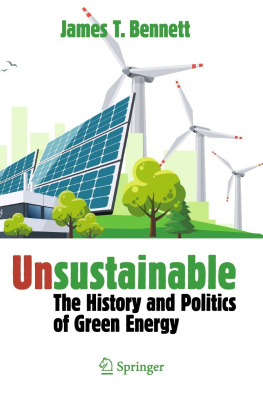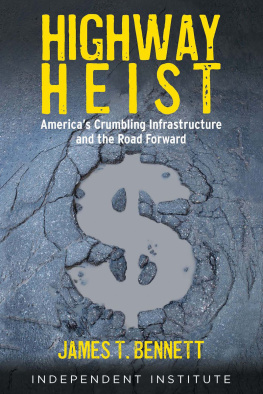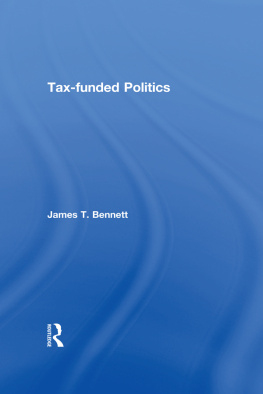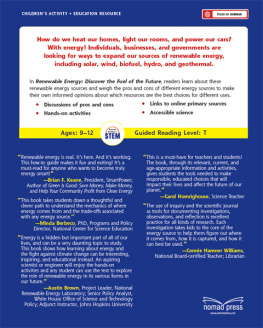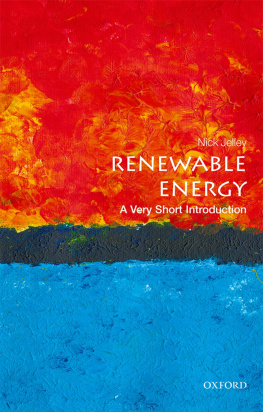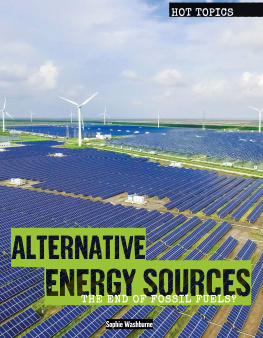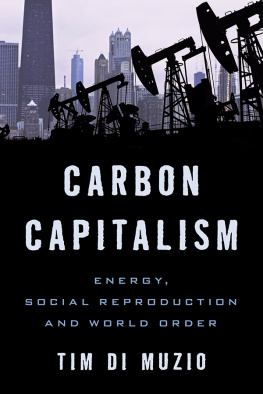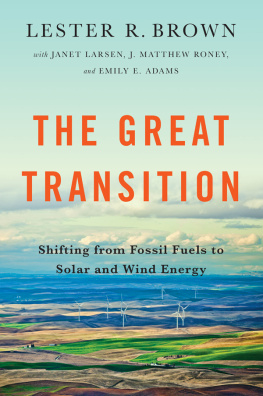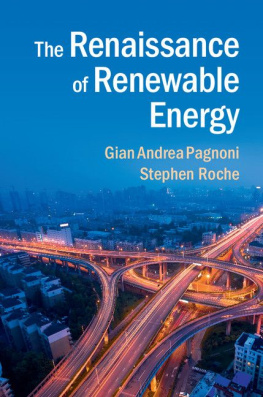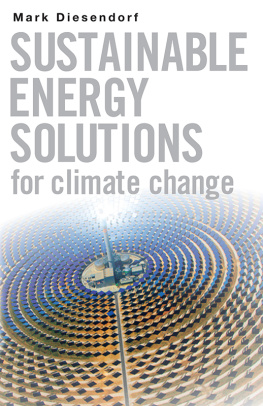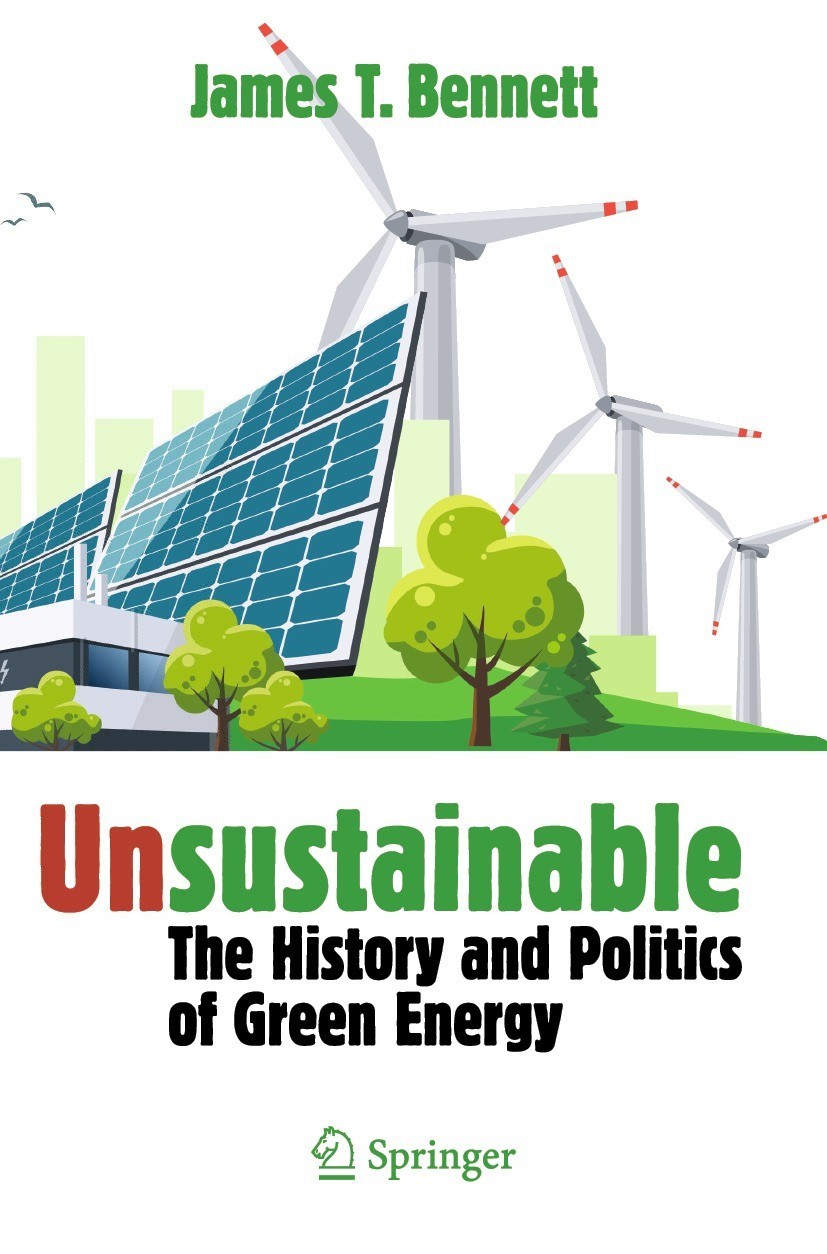James T. Bennett
Unsustainable
The History and Politics of Green Energy
1st ed. 2021

Logo of the publisher
James T. Bennett
Department of Economics, George Mason University, Fairfax, VA, USA
ISBN 978-3-030-78903-9 e-ISBN 978-3-030-78904-6
https://doi.org/10.1007/978-3-030-78904-6
The Editor(s) (if applicable) and The Author(s), under exclusive license to Springer Nature Switzerland AG 2021
This work is subject to copyright. All rights are solely and exclusively licensed by the Publisher, whether the whole or part of the material is concerned, specifically the rights of translation, reprinting, reuse of illustrations, recitation, broadcasting, reproduction on microfilms or in any other physical way, and transmission or information storage and retrieval, electronic adaptation, computer software, or by similar or dissimilar methodology now known or hereafter developed.
The use of general descriptive names, registered names, trademarks, service marks, etc. in this publication does not imply, even in the absence of a specific statement, that such names are exempt from the relevant protective laws and regulations and therefore free for general use.
The publisher, the authors and the editors are safe to assume that the advice and information in this book are believed to be true and accurate at the date of publication. Neither the publisher nor the authors or the editors give a warranty, expressed or implied, with respect to the material contained herein or for any errors or omissions that may have been made. The publisher remains neutral with regard to jurisdictional claims in published maps and institutional affiliations.
This Springer imprint is published by the registered company Springer Nature Switzerland AG
The registered company address is: Gewerbestrasse 11, 6330 Cham, Switzerland
Acknowledgements
I am especially grateful to my editor, Bill Kauffman, for I am indebted to him for significant contributions to this study. Bill has been a joy to work with and an inspiration for more than a decade. I also thank Andrew Thomas and Stuart Paul for their conscientious research assistance.
Contents
The Author(s), under exclusive license to Springer Nature Switzerland AG 2021
J. T. Bennett Unsustainable https://doi.org/10.1007/978-3-030-78904-6_1
1. Introduction and Overview
James T. Bennett
(1)
Department of Economics, George Mason University, Fairfax, VA, USA
Since the energy crisis of the 1970s, governments around the world have subsidized and otherwise incentivized alternative forms of energy to lessen dependence on fossil fuels. This search has taken on added urgency in the twenty-first century, as the specter of climate change has engendered ambitious state-level renewable portfolio standards, enhanced federal incentives, and inspired 100% renewable electrical generation targets in such states as Vermont and Hawaii.
Alternatives to fossil fuels sound as unobjectionable as a Boy Scout anti-littering campaign, as wholesome as the planting of a tree on Arbor Day. To save the planet from destruction, we must embrace wind, solar, and other renewable energy alternatives. But how did we get hereand what is all this costing us?
This book, Unsustainable: The History and Politics of Green Energy, examines the history, politics, and economics of alternative energy. After an in-depth study of the Carter administrations synthetic fuels program, the focus shifts to the two most prominent, perhaps most promising, and certainly most promotedand government-subsidizedgreen and renewable energies today: wind and solar. Because the former has made the most headway and drawn the most controversy, wind shall receive the most attention.
While the emphasis is on the American experience with alternative energy, the policies and politics of renewables in Scotland, Wales, Denmark, Spain, and other European nations are also discussed.
Issues considered include:
The nature and efficacy of renewable subsidies;
The employment of federal and state tax codes to encourage renewables;
The lobbies and interest groups that campaign for government support of renewables;
The fierce battles over the siting of renewable facilities.
The second chapter examines the checkered history of the previous much-hyped hope of alternative energy: synthetic fuels. The rendering of fuel from oil shale, liquefied coal, algae, or other sources, while technologically feasible, remained a back-burner project for most of the twentieth century until the energy crisis of the 1970s brought it to the fore. The creation of a quasi-federal entity, the Synthetic Fuels Corporation, was one of President Jimmy Carters signal achievements. But the SFC, which became an easy target for President Ronald Reagans budget cutters, was ultimately done in by the very thing that had hastened its birth: the fluctuations of energy prices.
Chapter explores the often colorful history of wind energy, which enjoyed a reputation as benign and pastoral until the advent of towering industrial wind turbines. The industry in its modern form received huge boosts in the 1970s and 1980s from the federal and state governments, particularly in California, where those seeking shelter from the tax storm found wind a profitable, if not terribly productive, option.
Chapter digs into the rich lode of government subsidies for the wind industry, including, most prominently, the federal Production Tax Credit (PTC), whose occasional lapses coincide with the virtual cessation of new wind projects, if not the wind itself, and which has helped to enrich such tax-equity investors as JP Morgan, GE Capital, and Warren Buffetts Berkshire Hathaway; and state-level Renewable Portfolio Standards (RPS) that require utilities to sell a rising percentage of their electricity from renewable sources. Without the PTC or the RPS, much of the wind industry would be dead on arrival.
Chapter assesses the dark side of wind energy: those drawbacks and disadvantages that industry spokespeople downplay and critics emphasize. Foremost among them are questions regarding the safety of birds: Are turbines avian Cuisinarts or is the death toll so small as to be a negligible concern? And what of bats and fish? For bipeds, the debate over Wind Turbine Syndrome involves whether the noises from these machines impose harmful physiological effects on nearby residents. Moreover, do turbines disturb sleep, or are those complaining of such effects predisposed to annoyance?
Chapter dives deeply into the raging controversies over the siting of industrial wind turbines. Going beyond the caricature of Not in My Backyard (NIMBY) opponents, the arguments made by critics of industrial wind as well as its defenders are rigorously analyzed. Who, exactly, are these critics? What is their gravamen? Is the legal and regulatory deck stacked against them? At which level of government should siting decisions be made? Site-specific controversies such as that over Cape Wind, a proposed offshore wind development that roused the Kennedy family and others on Marthas Vineyard and Nantucket to vigorous protest, are discussed.

